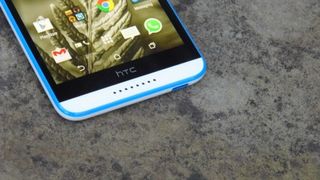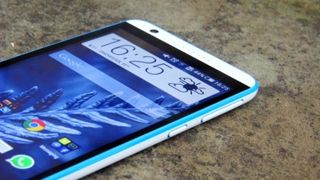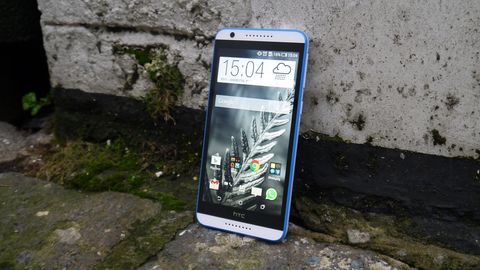Why you can trust TechRadar
Looking at the specs sheet of the HTC Desire 820 it is immediately clear what the two major selling points are going to be; that huge 8MP selfie camera and perhaps more importantly, the 64-bit architecture of Qualcomm's Snapdragon 615 SoC.
At this moment in time it might seem that having this chipset is a little redundant, and to a certain point you'd be correct. HTC clearly has a plan though, with Android 5.0 Lollipop the Desire 820 is perfectly placed to make use of its 64-bit support.
Couple this with an octa-core CPU and 2GB RAM and there is the potential for some serious speeds. Unfortunately given the lower price tag of the Desire 820, there was never going to be more RAM to make the most of the new architecture.
64-bit allows the use of more than 4GB RAM but it is likely that we won't see this level reach mobile phones for a few years, after all, we're still seeing laptops being sold with less.

There are definitely a few people that will question the need for these processors in mobile phones, but there is no doubt that having a 64-bit chip adds extra power.
Take a look at the iPhone 5S and 5C: theoretically there should be no difference as the dual CPU's are identically clocked (albeit a year's difference in model), but tests showed the iPhone 5S to be significantly more powerful.
It also stands to future proof the Desire 820. Not only does it make it fully compatible with a version of Android that has yet to fully launch, it adds further security that the 820 will be compatible with Android 6 (my guess is Android Meringue). Keeping with Google's 18 month update period, the Desire 820 should get the next two iterations, if not more.
The second major selling point for the Desire 820 has to be its whopping 8MP front sensor. It is pretty much a selfie lover's dream, and I couldn't be happier.

Compare it to the other major selfie players in the market (temporarily ignoring the Desire Eye), it stands head and shoulders above the likes of the HTC One M8 and Nokia Lumia 735's 5MP offerings.
Being an Android device also means that it comes with Snapchat out of the box, an app that has not only grown with, but has helped fuel, the selfie craze while simultaneously becoming one of my favourite apps.
Unfortunately the results didn't match up with what I was expecting. Images came out well in bright light but with even a hint of poor lighting images started to appear grainy.
HTC's live make up feature is enabled by default, with the idea that it automatically touches up your face to make you more beautiful. I wasn't impressed with the results here, as it applied a basic softening technique to the cheeks to disguise pores and left things feeling very unnatural.

The Desire 820 can also shout about its media capabilities. While it might only have a 720 x 1280 resolution, it does boast stereo speakers. These were loud enough and delivered some really impressive results, thanks to the HTC BoomSound technology built in.
That is where the high ends though. The screen initially seemed clear, but after browsing the web a little the fuzzy characters soon start to irk.

It is clear that this is an area that HTC has cut back on to save money, but a full HD screen at this size is almost essential for the Desire 820 to compete.
Performance
Those that are familiar with HTC's recent versions of Sense will be immediately at home with the Desire 820. For the rest, it is simple enough to learn. HTC has skinned Android KitKat (version 4.4.4) with Sense 6.0, sporting the latest version of Blinkfeed, although will still feel very familiar to traditional Android users.
Blinkfeed is HTC's effort to differentiate itself from other UI's, offering up customised feeds of news and social media to appeal to each user. In my case that means varying Facebook and Google+ posts, tweets, as well as technology and sports news feeds.
For the most part I found it to be very entertaining, with many news items appearing that I would likely have missed, however the integration of social media made it feel a little disjointed. Thankfully social media updates can be disabled.

Other areas of the OS have also taken a lick of paint, although there is a definite Android feel throughout. This is definitely a blessing because Google has put a lot of work into making Android a really well designed OS, and my favourite UI's are the ones that provide minimal skinning.
It should also be noted that HTC has moved a lot of its apps, such as the Gallery app and the Dot View app onto the Google Play Store with a view to streamlining the updates. When Android Lollipop hits in the coming months, this should make the process of updating the Desire 820 easier and faster.
In order to keep this all running, HTC has given the Desire 820 a 64-bit octa-core Snapdragon 615 SoC. As you may have guessed, this is undoubtedly the Desire 820's party piece. This is backed up with 2GB of RAM and helps keep the whole operation running smoothly.
Running the Geekbench 3 benchmarking app gave an average score of 2620, putting it amongst esteemed company with the Sony Xperia Z2, Galaxy S4 and just a few points short of the HTC One M8. It also sits alongside the Sony Xperia Z Ultra, the Japanese firm's own phablet device.
Company like this really highlights just how impressive the HTC Desire 820 is. Throughout day-to-day use it zipped around, heavy app lifting was done with ease and running multiple apps was also handled well.
Moving between home screens came with the same zip that is now expected of high end flagships, thanks to the upgraded chip architecture and twice the RAM that has become the norm for handsets of this price range. Even the iPhone 6 Plus comes with a mere 1GB RAM.
64-bit architecture allows twice the level of data to be processed, meaning that the CPU's should theoretically be twice as fast. The structure of Qualcomm's SoC should also help.
Four low-powered 1GHz cores tackle smaller tasks leaving four higher powered 1.5GHz cores to contend with the heavier lifting. Overall this allows for a more efficient CPU, making data processing faster as well as providing less strain on the battery.
Current page: Key features and performance
Prev Page Introduction Next Page Battery and the essentials
Vodafone wants to help UK SMBs get more productive than ever before

Nikon Z 40mm f/2 review: this cheap, modern 'nifty forty' has been my every day lens for over a year and it hasn't let me down

Could ChatGPT be the next big cybersecurity worry — researchers say it can crack systems faster than ever before
